|
|
|
Sort Order |
|
|
|
Items / Page
|
|
|
|
|
|
|
| Srl | Item |
| 1 |
ID:
147721
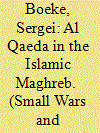

|
|
|
|
|
| Summary/Abstract |
After incurring significant losses during France’s 2013 Operation Serval in Mali, Al Qaeda in the Islamic Maghreb (AQIM) is back. Mokhtar Belmokhtar has rejoined the group, violent attacks are on the increase, and southern Libya offers elements of the group a new safe-haven. This article takes a long view on AQIM, looking at its objectives and ideology, organizational structure, relationship with the local population and revenue model to determine whether they should be labelled as terrorists, insurgents, or ordinary criminals. The article concludes that AQIM generally follows a strategy of terrorism, while some elements and modus operandi could also be indicative of a strategy of insurgency. AQIM’s primary commanders have a long-standing relationship with the global Al Qaeda movement, are unlikely to be seduced by the Islamic State, and enjoy significant autonomy in conducting their operations. There is, however, little evidence that supports the view that AQIM is a criminal organization behind a religious façade, and its Salafi–jihadist ideology remains a leading determinant.
|
|
|
|
|
|
|
|
|
|
|
|
|
|
|
|
| 2 |
ID:
147717
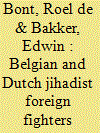

|
|
|
|
|
| Summary/Abstract |
In recent years, Belgium and the Netherlands have been confronted with relatively many citizens or residents who have traveled to Syria and Iraq to join and fight with jihadist groups — 388 Belgian and 220 Dutch as estimated by the respective authorities. This article provides an overview of the phenomenon of jihadist foreign fighters in the Low Countries, analyzing their characteristics, motivations, and roles in the war in Syria and Iraq. It compares the Belgian and Dutch cases, focusing on key aspects, such as age, sex, and geographical and socioeconomic background.
|
|
|
|
|
|
|
|
|
|
|
|
|
|
|
|
| 3 |
ID:
147716
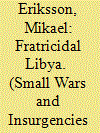

|
|
|
|
|
| Summary/Abstract |
This study explores the development of Libya’s security situation following the so-called Arab Spring in 2011 up to March 2016. It provides an overview of Libya’s main warring parties and the struggles they are engaged in. The analysis covers both domestic groups and the main external stakeholders. The study finds that the security dynamics are changing quickly and that Libya has many political hurdles and security challenges to overcome before a more durable situation of stability can be achieved.
|
|
|
|
|
|
|
|
|
|
|
|
|
|
|
|
| 4 |
ID:
147715
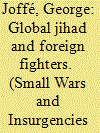

|
|
|
|
|
| Summary/Abstract |
One question that has been unresolved since the current phase of extremism began in the early- to mid-1990s has been whether or not there is a global structure to the jihadi phenomenon. This paper argues that no such definable structure exists, although regional, national, and local networks may well share common objectives and ideological ambitions. There has, in short, been a process of global branding that has developed that, in structural terms, corresponds to a ‘network of networks’. These objectives and the related praxis, moreover, have evolved over the years, going through three distinct stages of development, encapsulated in the strategic distinctions between al-Qa’ida, Ansar al-Shar’ia, and the Islamic State (Da’ish). Allied to this is a second consideration; namely that the formal ideological inspiration and justification for extremist activities is a set of integrated common insights that form a coherent ideology derived from a literalist interpretation of Islam, Salafism. A further aspect of the Salafi–jihadi phenomenon is to what degree this formal ideology is the real explanation of the appeal of these movements to their adherents, particularly to the so-called ‘foreign fighters’ – those who volunteer from countries not directly implicated in the specific conflicts in which they participate. This paper will argue that the phenomenon is far more complex than the superficial appeal of jihadist ideology would suggest. Finally, the paper will attempt to sketch out what the underlying causes of the intense wave of extremism sweeping the Middle East and North Africa might be and to what extent ‘blow-back’ from returning jihadis should be of concern to home governments.
|
|
|
|
|
|
|
|
|
|
|
|
|
|
|
|
| 5 |
ID:
147714
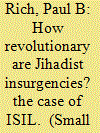

|
|
|
|
|
| Summary/Abstract |
This paper examines the rise of ISIL in the context of wider debates in the first half twentieth century on the nature and political direction of the early Bolshevik state model of Lenin, Trotsky, and Stalin. It argues that there are some parallels between the Trotskyite internationalist tendency in Soviet Russia and of ISIL given the latter’s calls for revolutionary jihad against both ‘apostate’ states in the Islamic world and, in the longer term, against the Western world as a whole. ISIL though is distinguished by its attempt to carve out a new state formation of its own in parts and Iraq and Syria, a project that may well end in failure. However, even if its so-called caliphate fails, it cannot be expected to vanish from the scene since it can either re-emerge elsewhere in a region of weak or failing states or merge with its current rival Al Qaeda.
|
|
|
|
|
|
|
|
|
|
|
|
|
|
|
|
| 6 |
ID:
147713


|
|
|
|
|
| Summary/Abstract |
The rise of the Islamic State (ISIS/ISIL) is not well understood at this point. This paper starts by comparing the Islamic State to the Vietnamese communists in a revolutionary warfare framework and makes a causal argument that the Islamic State’s defeat of the Sahwa (Awakening) movement in Iraq was the key to its successful establishment of control of most Sunni areas and the mobilization of its population for support. Islamic State operational summaries and captured documents are used to quantitatively establish the impact of the subversion campaign against the Sahwa and Iraqi government and trace the efforts of operatives in tribal outreach and recruiting. This research provides a valuable insight into the return of a powerful method of insurgency as well as a glimpse into the vast clandestine network that provides the strength of the Islamic State movement.
|
|
|
|
|
|
|
|
|
|
|
|
|
|
|
|
| 7 |
ID:
147723
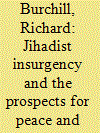

|
|
|
|
|
| Summary/Abstract |
Modern jihadist insurgency movements pose a threat to global peace and security. Modern jihadist insurgencies are not necessarily posing new operational challenges, instead it is the ideology and belief systems justifying the use of violence that we need to understand better. The ideology fuelling modern jihadist insurgencies, motivating the fighters, acting as a tool for recruiting and support is the key strength these groups have and the one area we have yet to adequately address. We must work to better understand this ideology and how it is utilised otherwise the threat from violent jihadist movements may continue for a very long time.
|
|
|
|
|
|
|
|
|
|
|
|
|
|
|
|
| 8 |
ID:
147720
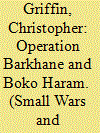

|
|
|
|
|
| Summary/Abstract |
This article examines the current coalition campaign against Boko Haram in Nigeria in the context of French military cooperation with the Francophone countries involved. The French government is actively supporting and facilitating the offensive against Boko Haram through both structural and operational military cooperation with Chad, Niger, and Cameroon. The current effectiveness and operational state of the armies in those three countries is largely due to long-term French strategic thinking about its influence on the continent. Finally, France is also militarily active on the continent with 3000 soldiers deployed for Operation Barkhane. Barkhane, while primarily aimed at containing the threat of Al Qaeda in the Islamic Maghreb, is also designed, in cooperation with partner countries, to prevent a link-up between Boko Haram and the other terrorist groups in the Sahel.
|
|
|
|
|
|
|
|
|
|
|
|
|
|
|
|
| 9 |
ID:
147719


|
|
|
|
|
| Summary/Abstract |
Boko Haram is an Islamic sect turned terrorist group. Despite its ethnic leaning, it is not a liberation front, and it does not advocate a people’s revolution. From an ideological point of view, it is a jihadist movement because it fights for full implementation of strict sharia law which would require a change of political regime and the establishment of an Islamic state. But it does not really follow the Wahhabi model of Al Qaeda or Daesh, unlike AQIM in Northern Mali or Al Shabaab in Somalia. In the region of Greater Borno, which encompasses parts of Nigeria, Chad, Niger, and Cameroon, the sect remains embedded in local dynamics which this article explores through an analysis of the mobilization of its members.
|
|
|
|
|
|
|
|
|
|
|
|
|
|
|
|
| 10 |
ID:
147722
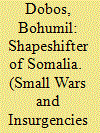

|
|
|
|
|
| Summary/Abstract |
The article presents the application of a concept of political territoriality in the case of Al-Shabaab. It first presents territoriality as a human strategy based on control of territory. Hereinafter, the set of criteria for the examination of political territoriality is presented. It concludes that given the development of Al-Shabaab, we can identify three distinct periods connected to the ′organization’s relation to territory: 2006–2008 – defiance; 2009–2011 – supremacy; and 2012–present – withdrawal. The issue of the deterritorialization of Al-Shabaab since 2012 is also connected to the need to enhance the strategies used against the group as it is becoming more connected to population and functional identification than territory.
|
|
|
|
|
|
|
|
|
|
|
|
|
|
|
|
| 11 |
ID:
147718
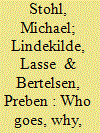

|
|
|
|
|
| Summary/Abstract |
This article explores the phenomenon of Islamist foreign fighters, more specifically the movement of European Muslims to participate in the insurgencies in Syria and Iraq connected to the Islamic State/Daesh as well as the anti-Assad forces in Syria and the implications for European state stability. Drawing on personal psychology, social psychology, and social movement theory the article offers an integrated theoretical framework to analyze the radicalization of Islamist foreign fighters. Building on Danish data of Islamist foreign fighters, the article provides a first test of the analytical usefulness of this framework. The article further considers what distinguishes the Islamists that go from those that under similar circumstances stay behind, and whether this is a differences of kind or a difference of degree. Finally, we discuss the question of how much of a threat foreign fighter returnees pose to European states.
|
|
|
|
|
|
|
|
|
|
|
|
|
|
|
|
|
|
|
|
|